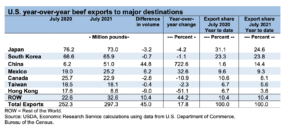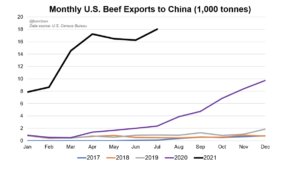The USDA is projecting that the ag trade deficit will shrink in FY2026 even more than previously anticipated. USDA expects the trade deficit to fall from $43.7 billion in FY2025…
U.S. Beef Exports Increase, Reflecting Large Shipments to China
In its monthly Livestock, Dairy, and Poultry Outlook report last week, USDA’s Economic Research Service (ERS) stated that, “In July, U.S. beef exports totaled 297 million pounds, exceeding last July’s exports by 17.9 percent or 45 million pounds.
The rise in part reflects large shipments of U.S. beef to China, the largest U.S. beef exports to China, ever recorded, totaling almost 45 million pounds more than the previous year.
“Total beef exports for the January–July period in 2021 were up 21 percent over the first 7 months of 2020, with 14.4 percent being shipped to China.”

Also with respect to U.S. beef exports, the ERS report noted that, “The forecasts for 2021 third and fourth quarters were raised 20 million and 10 million pounds to 900 and 845 million pounds, respectively, on anticipated strong beef demand from key trading partners. The annual forecast for 2021 was revised up 30 million pounds to 3.414 billion pounds. The forecast for 2022 was unchanged from last month at 3.270 billion pounds.”

Meanwhile, Reuters columnist Karen Braun pointed out this week that, “January-July U.S. beef exports to China topped 99,000 tonnes, accounting for 12% of exports to all destinations versus 1.3% in all of last year. So far in 2021, China is the No. 4 recipient of U.S. beef behind Japan, South Korea and Mexico, up from No. 8 in 2020 and No. 13 in 2019.”

The Reuters column added that, “Beef’s priciness versus other meats makes those exports stand out in terms of dollar value. At $773 million, U.S. beef exports to China in the first seven months of the year accounted for 4.5% of all U.S. agricultural exports to the Asian country versus 1% in full-year 2020.
“That puts beef at No. 7 on the list so far this year. Corn was the top U.S. product to China between January and July, valued at $4.1 billion, and soybeans placed second at $3.6 billion.”





